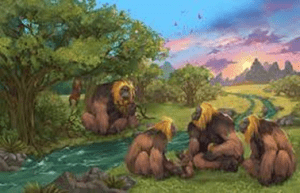TAG: GS 3: ECOLOGY AND ENVIRONMENT
THE CONTEXT: The extinction of Gigantopithecus blacki, the largest known primate in Earth’s history, has long intrigued scientists. A recent study published in Nature sheds light on the demise of this colossal ape, attributing its extinction to challenges in adapting to profound environmental changes.
EXPLANATION:
- This research not only deepens our understanding of the fate of Gigantopithecus but also provides crucial insights into the delicate balance between species survival and environmental transformations.
- Gigantopithecus blacki, standing at an estimated height of 3 meters and weighing 200–300 kilograms, was a giant ape species that inhabited China from 2 million to 330 thousand years ago.
- As the largest primate ever to roam the Earth, its extinction has remained a puzzle until now.

Fossil Collection and Dating
- Researchers conducted a meticulous analysis, collecting and dating fossil samples from 22 caves in southern China.
- Focusing on G. blacki and its closest primate relative, Pongo weidenreichi, the team aimed to unravel the timeline and reasons behind the decline of Gigantopithecus.
Environmental Context: Pollen and Stable Isotope Analysis
- To reconstruct the environment during G. blacki’s extinction window, the researchers employed pollen and stable isotope analysis.
- Two million years ago, dense forests with heavy cover prevailed, providing ideal conditions for G. blacki.
- However, as the extinction window (295–215,000 years ago) approached, a notable shift occurred, leading to open forests dominating the landscape.
Dietary Changes and Dental Analyses
- Dental analyses played a crucial role in understanding the dietary adaptations of G. blacki during this critical period.
- The transition to open forests coincided with a decline in the diversity of G. blacki’s diet and a reduction in regular water consumption.
- This shift, reflected in the teeth, suggests an inability to cope with the changing environment.
- In contrast, P. weidenreichi exhibited better adaptation, maintaining a more diverse diet with less stress.
Increased Chronic Stress: A Sign of Struggle
- The researchers uncovered signs of increased chronic stress among G. blacki during the extinction window.
- This stress, manifested in dental and skeletal indicators, highlights the species’ struggle to adapt to the evolving landscape.
- weidenreichi, on the other hand, demonstrated a more resilient response to changing conditions.
Geographical Contraction and Fossil Records
- An intriguing aspect of the study is the examination of fossil numbers and their geographical spread.
- 300 thousand years ago, there was a noticeable decline in both the number and distribution of G. blacki fossils relative to P. weidenreichi.
- This decline in fossil records provides tangible evidence of the challenges faced by Gigantopithecus during its dwindling existence.
Implications for Understanding Extinction Events
- The findings offer valuable insights into the interplay between environmental changes and the extinction of a species.
- The inability of Gigantopithecus to adapt to shifting ecosystems serves as a cautionary tale, emphasizing the vulnerability of even the most massive creatures in the face of rapid environmental transformations.
Conclusion: A Eulogy for Gigantopithecus
- In unraveling the mysteries surrounding the extinction of Gigantopithecus blacki, this study presents a poignant narrative of a giant ape struggling against the currents of environmental change.
- The lessons learned from this ancient primate’s demise contribute to our broader understanding of how species respond to ecological shifts, offering perspectives that resonate in our ongoing efforts to preserve biodiversity in a rapidly changing world.


